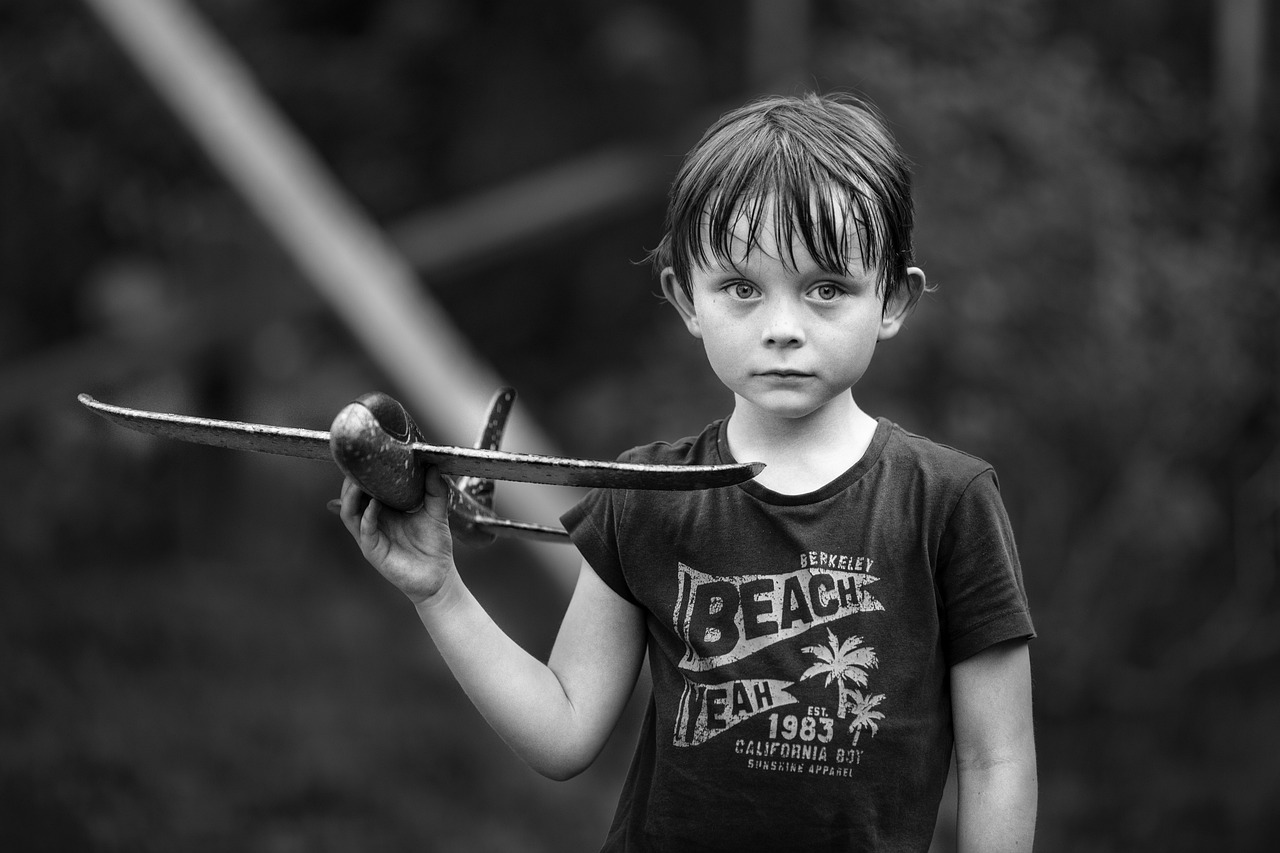10 Easy Self-Defense Techniques for Children
This article provides parents and guardians with practical self-defense techniques that children can learn easily. Each technique is designed to empower children and enhance their safety awareness in various situations.
Self-defense is crucial for children as it helps build confidence and awareness. Imagine your child walking home from school, feeling secure and capable of handling unexpected situations. Learning self-defense techniques can empower children to protect themselves in dangerous situations, fostering a sense of security and independence. It's not just about physical skills; it’s about instilling a mindset that encourages vigilance and assertiveness. When children understand that they have the tools to defend themselves, they are more likely to navigate their environments with confidence, reducing the likelihood of becoming victims.
Teaching children the fundamental stance and movement is essential for effective self-defense. Think of a sturdy tree standing tall against the wind; that’s the kind of stability a strong stance provides. A solid base allows children to maintain balance and react swiftly to threats. Agile movements enable quick responses to potential dangers, ensuring their ability to evade danger. Encourage your child to practice shifting their weight and moving side to side, as this can help them escape from an attacker more effectively. A good stance is the foundation of all self-defense techniques, and mastering it can make a world of difference in a critical moment.
Verbal assertiveness is a key self-defense technique that children can use to deter potential aggressors. Teaching them to speak confidently and firmly can help them assert boundaries and gain control of a situation. Imagine if your child could stand their ground simply by using their voice; this is a powerful skill! Role-playing scenarios where they practice saying phrases like "Leave me alone!" or "I don’t want to play!" can greatly enhance their confidence. This technique not only helps in physical confrontations but also empowers them in everyday situations, making them less likely to be targeted by bullies or aggressors.
Children should learn basic escape techniques to free themselves from holds or grips. These techniques focus on leveraging body mechanics to create space and escape from an attacker, enhancing their chances of safety. For instance, if someone grabs their wrist, teaching them to rotate their wrist and step back can help them break free. Practicing these moves in a safe environment can build muscle memory, so when a real situation arises, they will instinctively know what to do. Remember, the goal is not to fight back but to escape and seek help.
Children can be taught to use everyday objects as improvised self-defense tools. Items like backpacks, umbrellas, or even keys can serve as effective deterrents, providing children with options to protect themselves. Just think about it: your child's backpack can be more than just a school bag; it can be a shield. Encourage them to be creative and think about how they can use what they have on hand. For example, holding their keys between their fingers can make a strong fist, while an umbrella can be used to push an aggressor away. Teaching them to see ordinary items as potential tools for defense can empower them in unexpected ways.
Awareness of surroundings plays a vital role in self-defense. Teaching children to recognize potentially dangerous situations helps them develop instincts and avoid confrontations before they escalate, promoting proactive safety measures. For instance, encourage them to avoid isolated areas and to trust their gut feelings. If something doesn’t feel right, it probably isn’t. Discussing real-life scenarios and helping them understand the signs of danger can greatly enhance their awareness. By fostering a habit of observation, children can learn to navigate their environments more safely.
Regular practice of self-defense techniques is essential for retention and confidence. Engaging in drills and role-playing scenarios allows children to become familiar with their skills, ensuring they can react effectively in real-life situations. Consider setting aside time each week for practice, turning it into a fun family activity. The more they practice, the more natural these responses will become. Just like learning to ride a bike, repetition is key. When children feel confident in their abilities, they are less likely to panic when faced with a real threat.
Building confidence and resilience is a crucial aspect of self-defense training. Encouraging children to face challenges and setbacks fosters a strong mindset, empowering them to stand firm in the face of adversity. Praise their efforts, no matter how small, and remind them that mistakes are part of learning. This approach not only helps them in self-defense situations but also in everyday life, as they learn to face obstacles head-on. By nurturing their self-esteem, parents can help their children grow into capable individuals who are ready to tackle any challenge that comes their way.
- What age is appropriate for children to start learning self-defense? Generally, children as young as 5 can begin learning basic self-defense concepts, but it’s essential to tailor the techniques to their age and maturity level.
- Can self-defense training help with bullying? Yes, self-defense training can empower children to stand up to bullies verbally and physically if necessary, while also teaching them to avoid confrontations when possible.
- How can I reinforce these techniques at home? Regular discussions about safety, role-playing scenarios, and encouraging your child to practice techniques can reinforce their learning at home.

Understanding the Importance of Self-Defense
This article provides parents and guardians with practical self-defense techniques that children can learn easily. Each technique is designed to empower children and enhance their safety awareness in various situations.
Self-defense is not just about physical techniques; it’s about building confidence and fostering a sense of awareness in children. Imagine a child walking down the street, feeling empowered and aware of their surroundings, rather than fearful and anxious. This empowerment is what self-defense training provides. When children learn how to protect themselves, they develop a sense of security that can positively impact their overall well-being.
Moreover, understanding self-defense is crucial in today’s world where children may encounter various situations that could potentially be dangerous. It’s not merely about reacting to an attack; it’s about recognizing threats and being prepared to handle them. For instance, teaching children to identify suspicious behavior or unsafe environments can help them avoid confrontations before they escalate. This proactive approach is invaluable.
Additionally, self-defense training can significantly enhance a child's mental resilience. It teaches them to stay calm under pressure, think critically, and make quick decisions. These skills are not only useful in physical confrontations but also in everyday challenges. By learning self-defense, children gain a toolkit that equips them to navigate the complexities of life with confidence and assertiveness.
In essence, self-defense is about more than just fighting back; it’s about empowering children to take control of their safety and well-being. It’s about instilling a mindset that encourages them to be aware, prepared, and confident. As parents and guardians, fostering this understanding in children is one of the most valuable gifts we can provide.
Teaching children the fundamental stance and movement is essential for effective self-defense. A strong stance provides stability, while agile movements enable quick responses to potential threats, ensuring their ability to evade danger.
Verbal assertiveness is a key self-defense technique that children can use to deter potential aggressors. Teaching them to speak confidently and firmly can help them assert boundaries and gain control of a situation.
Children should learn basic escape techniques to free themselves from holds or grips. These techniques focus on leveraging body mechanics to create space and escape from an attacker, enhancing their chances of safety.
Children can be taught to use everyday objects as improvised self-defense tools. Items like backpacks, umbrellas, or even keys can serve as effective deterrents, providing children with options to protect themselves.
Awareness of surroundings plays a vital role in self-defense. Teaching children to recognize potentially dangerous situations helps them develop instincts and avoid confrontations before they escalate, promoting proactive safety measures.
Regular practice of self-defense techniques is essential for retention and confidence. Engaging in drills and role-playing scenarios allows children to become familiar with their skills, ensuring they can react effectively in real-life situations.
Building confidence and resilience is a crucial aspect of self-defense training. Encouraging children to face challenges and setbacks fosters a strong mindset, empowering them to stand firm in the face of adversity.
- Why is self-defense important for children? Self-defense empowers children with the skills and confidence to protect themselves in potentially dangerous situations.
- At what age should children start learning self-defense? Children can start learning basic self-defense techniques as early as age 5, depending on their maturity and understanding.
- Can self-defense training help with bullying? Yes, self-defense training can help children respond to bullying situations with confidence and assertiveness.
- What if my child is not physically strong? Self-defense is not solely about strength; it emphasizes technique, awareness, and mental resilience, which are crucial for all children.

Basic Stance and Movement
When it comes to self-defense, the are the cornerstones of effective techniques. Think of it like the foundation of a house; without a strong base, everything else can come crashing down. Teaching children how to position themselves correctly can make all the difference in a tense situation. A strong stance not only provides stability but also allows for quick and agile movements, which are essential for evading potential threats.
Imagine standing firm with your feet shoulder-width apart, knees slightly bent, and weight evenly distributed. This is what we call the defensive stance. It’s like being a sturdy tree in a storm—rooted and ready to sway but not break. In this position, children can easily shift their weight to either foot, allowing for swift responses to any sudden movements from an aggressor. The key here is to make them feel comfortable and confident in their stance, so they can react without hesitation.
Now, let’s talk about movement. Children should learn to employ side-stepping and pivoting techniques. These movements are akin to a dancer gliding across the floor—fluid and graceful. By practicing lateral movements, they can create distance from a potential threat, making it harder for an attacker to reach them. Encourage them to keep their hands up, ready to defend themselves, while maintaining a low center of gravity. This posture not only prepares them to react but also makes them appear more assertive, which can deter aggressors.
To make this learning process engaging, consider incorporating fun drills. For example, you can set up an obstacle course that requires them to move in different directions while maintaining their stance. This not only reinforces their skills but also builds their confidence. Remember, practice makes perfect, and the more they rehearse these movements, the more instinctive they will become.
In conclusion, mastering the basic stance and movement is crucial for children learning self-defense. It’s all about empowering them with the ability to stand their ground and move effectively. With a solid foundation, they’ll be better equipped to handle any situation that comes their way. So, let’s help our kids become those strong trees, ready to withstand the winds of adversity!
- Why is posture important in self-defense? A strong posture allows for better balance and quicker reactions, which are essential in self-defense situations.
- How can I help my child practice their stance? Engage them in fun activities like obstacle courses or games that require them to maintain their stance while moving.
- What should my child do if they feel threatened? Encourage them to trust their instincts, maintain their stance, and look for opportunities to escape or seek help.

Verbal Assertiveness
Verbal assertiveness is a powerful self-defense technique that every child should learn. Imagine a situation where a child feels threatened or uncomfortable; having the ability to express themselves confidently can make all the difference. It's not just about shouting or being loud; it's about using a firm, clear voice to communicate boundaries. Teaching children to say "no" firmly and to express their feelings can deter potential aggressors more effectively than physical actions in many scenarios.
To help children practice verbal assertiveness, parents can engage in role-playing exercises. This not only makes learning fun but also prepares them for real-life situations. For instance, a parent can pretend to be an aggressor and challenge the child to respond assertively. It's essential to emphasize that their tone should be confident yet calm, and their body language should reflect their words. Standing tall, making eye contact, and using a strong voice can significantly enhance their assertiveness.
Here are some key phrases that children can practice to assert themselves:
- "Leave me alone!" - A clear and direct command that leaves no room for misinterpretation.
- "I don’t like that!" - Expressing discomfort can often stop unwanted behavior.
- "Stop it!" - A firm request that signals the behavior must end immediately.
In addition to practicing these phrases, children should be encouraged to understand their emotions and articulate them. For example, if someone is teasing them, they can say, "I feel sad when you say that." This not only asserts their feelings but also communicates the impact of the aggressor's actions. By teaching children to connect their emotions with their words, they're more likely to express themselves effectively and assertively.
Moreover, it's crucial to reinforce the idea that being assertive doesn't mean being aggressive. There's a fine line between standing up for oneself and being confrontational. Children should be taught to maintain respect for others while also standing firm in their boundaries. This balance is key to ensuring that they can navigate social situations safely and confidently.
In summary, verbal assertiveness is a vital skill that empowers children. By practicing clear communication, role-playing scenarios, and understanding their emotions, children can develop the confidence needed to assert themselves in potentially dangerous situations. Remember, the goal is not just to react but to proactively establish boundaries that can prevent confrontations before they escalate.
- What is verbal assertiveness? - Verbal assertiveness is the ability to express one’s feelings and boundaries clearly and confidently, helping to deter potential threats.
- How can I help my child practice verbal assertiveness? - Engage in role-playing exercises, encourage them to use assertive phrases, and reinforce positive body language.
- Is verbal assertiveness the only self-defense technique my child should learn? - While it is a crucial skill, combining it with physical techniques and awareness of surroundings will provide a more comprehensive self-defense strategy.

Simple Escape Techniques
When it comes to self-defense for children, one of the most empowering skills they can learn is how to escape from holds or grips. Imagine being caught in a tight hug that you can’t get out of; it can feel overwhelming and scary. But with the right techniques, children can learn to turn that fear into action. The key here is to focus on using their body mechanics to create space and escape from an attacker.
First, let’s talk about the importance of body positioning. Children should be taught to keep their center of gravity low, which makes them more stable and less likely to be thrown off balance. For example, if someone grabs their wrist, they can pivot their body towards the attacker while simultaneously pulling their wrist away. This action not only disrupts the grip but also allows them to escape quickly.
Another effective technique involves using their body weight. If a child is grabbed from behind, they can lean forward and drop their weight, making it harder for the attacker to hold on. This technique, often referred to as the “drop and roll,” can be incredibly effective. By dropping their weight, they create a moment of surprise that can lead to a quick escape.
Children can also learn to use their elbows and knees to create space. For instance, if someone is holding them from the front, they can use their elbows to strike the attacker’s ribs or stomach. This sudden movement can cause enough distraction for them to break free. It’s all about making the attacker lose their grip, allowing the child to escape.
To make these techniques more relatable, you can practice them in a fun and engaging way. Role-playing scenarios can help children visualize and understand how to react in real-life situations. For example, you might set up a mock situation where they need to escape from a friend who pretends to grab them. This not only makes it fun but also reinforces the techniques they’ve learned.
Here’s a quick summary of some simple escape techniques:
| Technique | Description |
|---|---|
| Wrist Escape | Pivot and pull away while turning towards the attacker. |
| Drop and Roll | Lean forward and drop weight to break free from a hold. |
| Elbow Strike | Use elbows to strike the attacker's ribs or stomach to create space. |
By teaching children these simple yet effective escape techniques, we are not just equipping them with physical skills; we are also instilling a sense of confidence and empowerment. They learn that they have the ability to take control of a situation and that their safety is in their own hands. Ultimately, the goal is to ensure that they feel secure in knowing how to protect themselves, and that’s a lesson that will last a lifetime.
- What age is appropriate for teaching self-defense techniques to children? Generally, children as young as 5 can start learning basic self-defense techniques, but it's essential to tailor the instruction to their age and maturity level.
- Are these techniques safe for children to practice? Yes, when taught in a controlled environment with proper supervision, these techniques can be practiced safely.
- How can I reinforce these techniques at home? Regular practice through role-playing and discussing scenarios can help reinforce the techniques and boost their confidence.

Using Everyday Objects for Defense
In a world where safety is paramount, teaching children to utilize everyday objects as self-defense tools can be a game-changer. Imagine your child walking home from school, and they notice someone suspicious following them. Instead of feeling helpless, they can quickly grab an item from their backpack or pocket to protect themselves. This not only boosts their confidence but also gives them practical skills to handle unexpected situations.
Everyday items can be surprisingly effective in self-defense scenarios. For instance, a simple backpack can be used to shield against an attack. If a child feels threatened, they can swing their backpack to create distance or even use it to block an aggressor. Similarly, an umbrella can serve as a defensive tool; it can be opened quickly to create a barrier or jabbed towards an attacker to deter them. Even keys, when held between fingers, can provide a sense of security and can be used to scratch or poke if necessary.
Here’s a quick overview of some common items and how they can be used for self-defense:
| Everyday Object | Potential Use |
|---|---|
| Backpack | Shield against attacks; create distance |
| Umbrella | Block or jab; create distance |
| Keys | Hold between fingers for protection; scratch or poke |
| Water Bottle | Throw to distract; use as a blunt object |
| Phone | Call for help; throw to distract |
It's essential to practice these techniques in a safe environment. Role-playing scenarios can help children become familiar with how to use these items effectively. For example, during a practice session, a child can pretend to be approached by a stranger and then decide which object to use and how. This kind of training not only prepares them for real-life situations but also reinforces the idea that they have the power to defend themselves.
Moreover, teaching children about situational awareness is equally important. They should be encouraged to assess their surroundings and identify potential dangers. By doing so, they can make informed decisions about when and how to use everyday objects for self-defense. Remember, the goal is to empower them, not to instill fear. With the right mindset and tools, children can feel more secure and confident in their ability to handle challenging situations.
- What should I teach my child about using everyday objects for defense? Start with common items they carry, such as backpacks, keys, and water bottles. Teach them how to use these items in various scenarios.
- Is it safe for children to practice self-defense techniques? Yes, as long as they practice in a controlled environment under adult supervision. Role-playing can be a fun and effective way to learn.
- How can I encourage my child to be more aware of their surroundings? Engage them in discussions about their daily environments and encourage them to notice details, such as exits, people around them, and potential escape routes.

Recognizing Dangerous Situations
Being aware of one's surroundings is a vital skill that can significantly enhance a child's safety. Children often find themselves in situations where they might not feel comfortable, whether it's in a crowded park, at school, or even while walking home. The ability to recognize dangerous situations is the first step toward ensuring their safety. It’s like having a sixth sense that alerts them when something feels off. Imagine being a superhero who can sense danger before it strikes!
To help children develop this crucial awareness, it's essential to teach them to observe their environment actively. Encourage them to pay attention to the people around them, the activities happening nearby, and any unusual behavior. For instance, if they notice someone acting suspiciously—like loitering too long or watching them intently—they should trust their instincts and consider it a potential threat. This is not just about being paranoid; it’s about being smart and cautious.
Here are some key indicators that children should be taught to recognize:
- Unfamiliar People: If someone approaches them who they don’t know, especially if they seem overly friendly or insistent, it’s a red flag.
- Strange Behavior: Look for signs of aggression, excessive attention, or people who seem to be following them.
- Isolation: If they find themselves in a situation where they are alone with someone they don’t know well, they should feel empowered to remove themselves from that situation.
- Changes in Environment: If a normally safe place feels different—like being deserted or having unfamiliar people around—it’s wise to be cautious.
Additionally, role-playing different scenarios can be a fun and effective way to help children practice recognizing these signs. Create hypothetical situations where they need to identify what feels wrong and how to react. This not only makes the learning process engaging but also helps cement their understanding of what to look out for.
Lastly, remind them that it’s perfectly okay to trust their gut feelings. If something feels wrong, it probably is. Encourage them to talk about their feelings and experiences, fostering an open line of communication. This way, they’ll feel more comfortable sharing any concerns with you, which is crucial for their safety.
Q: What should my child do if they feel unsafe?
A: If your child feels unsafe, they should seek help immediately. This could mean finding a trusted adult, calling a parent, or even dialing emergency services if necessary.
Q: How can I help my child practice recognizing dangerous situations?
A: Engage in role-playing exercises where you simulate various scenarios. Discuss what they should look for and how they should react. Make it fun and interactive!
Q: Is it normal for children to feel scared in certain situations?
A: Yes, it is completely normal for children to feel scared. Teaching them to recognize and respond to those feelings is an important part of their development.

Practicing Self-Defense Techniques
When it comes to self-defense, practice is not just a suggestion; it's a necessity. Regularly practicing self-defense techniques helps children internalize what they've learned, making it second nature when they need to react in a real-life situation. Imagine it like riding a bike; the more you practice, the more confident you become. Children should engage in drills that reinforce their skills, ensuring they can perform them under pressure. This can be done through fun and interactive sessions that keep them engaged.
One effective way to practice is through role-playing scenarios. Parents or guardians can set up mock situations where children can apply their techniques in a controlled environment. For instance, you might simulate a situation where a stranger approaches them, allowing them to practice their verbal assertiveness and escape techniques. This not only builds their confidence but also teaches them how to think on their feet.
Additionally, practicing in groups can enhance the learning experience. Children can take turns being the 'attacker' and the 'defender,' which helps them understand both sides of a confrontation. This collaborative practice can include various techniques, such as:
- Basic stances and movements
- Verbal assertiveness drills
- Escape techniques from different holds
- Using everyday objects for defense
Moreover, consistency is key. Setting aside a regular time each week for practice not only reinforces their skills but also turns self-defense into a fun activity. Incorporating games or challenges can make these practice sessions enjoyable. For example, you could create obstacle courses that require them to use their self-defense techniques while navigating through various challenges. This not only makes practice enjoyable but also mimics real-life scenarios where they may need to think quickly.
Lastly, it's essential to celebrate their progress. Positive reinforcement can go a long way in building their self-esteem. Whether it's through verbal praise or small rewards, acknowledging their efforts encourages them to keep practicing and improving. Remember, the goal is to empower children, so fostering a supportive environment is crucial. With regular practice, they'll not only learn how to defend themselves but also gain a sense of independence and confidence that will serve them well throughout their lives.
Q: At what age should children start learning self-defense?
A: Children can start learning basic self-defense techniques as early as age 5, but the complexity of the techniques can increase as they grow older.
Q: How often should children practice self-defense?
A: Ideally, children should practice self-defense techniques at least once a week to retain their skills and build confidence.
Q: Can self-defense training help with bullying?
A: Yes, self-defense training can empower children to stand up to bullies and give them the tools to avoid or de-escalate potentially harmful situations.
Q: What if my child is not interested in self-defense?
A: It's important to make the practice engaging and fun. Consider incorporating games or group activities to spark their interest.
Q: Should self-defense training be done alone or in groups?
A: Both individual and group practices are beneficial. Group practice can provide social interaction and teamwork, while individual practice allows for personal focus and improvement.

Encouraging Confidence and Resilience
Building confidence and resilience in children is one of the most significant benefits of self-defense training. These qualities not only help them in self-defense situations but also equip them to face life's challenges head-on. Imagine a child who walks into a room with their head held high, ready to tackle any obstacle that comes their way. This is the power of confidence!
To foster this confidence, it's essential to create an environment where children feel safe to express themselves and try new things. Encouragement from parents and guardians plays a pivotal role here. When children know they have a support system cheering them on, they are more likely to take risks and step out of their comfort zones. For instance, if a child is hesitant to participate in a self-defense class, a simple phrase like, "I believe in you; you can do this!" can work wonders.
Resilience, on the other hand, is about bouncing back from setbacks. In self-defense training, children will inevitably face challenges, whether it's mastering a new technique or dealing with a difficult sparring partner. It's vital to remind them that failure is not the end; rather, it's an opportunity to learn and grow. Just like a rubber band stretches and snaps back into shape, children too can develop resilience through practice and perseverance.
One effective way to teach resilience is through storytelling. Share stories of famous personalities who faced adversity but triumphed in the end. For example, you could talk about someone like J.K. Rowling, who faced numerous rejections before finally publishing the Harry Potter series. This not only inspires children but also helps them understand that challenges are a part of life.
Incorporating fun and engaging activities can also boost confidence and resilience. Consider organizing friendly competitions or challenges within self-defense classes. This can help children learn to handle both victory and defeat gracefully, reinforcing the idea that it's not just about winning but about participating and improving.
Moreover, teaching children to set small, achievable goals can significantly enhance their confidence. For instance, they might aim to learn a new technique each week or improve their speed in drills. As they accomplish these goals, their self-esteem will naturally grow. Celebrate these achievements, no matter how small, to reinforce their sense of accomplishment.
Lastly, it's essential to remind children that confidence and resilience are skills that can be developed over time. They are not innate traits but rather qualities that can be nurtured through consistent practice and positive reinforcement. Encourage them to reflect on their experiences, recognize their progress, and understand that every step they take is a part of their journey toward becoming stronger individuals.
- Why is self-defense training important for children?
Self-defense training empowers children by building their confidence and teaching them how to handle potentially dangerous situations effectively. - How can I encourage my child to practice self-defense?
Make it fun! Participate in training sessions together, celebrate their progress, and remind them of the benefits of being prepared. - What age is appropriate to start self-defense training?
Children as young as five can begin learning basic self-defense techniques, but it's essential to choose age-appropriate classes. - Can self-defense training help with bullying?
Absolutely! Self-defense training teaches children to stand up for themselves, assert boundaries, and develop the confidence to walk away from confrontations.
Frequently Asked Questions
- What age is appropriate for children to start learning self-defense?
Children can start learning basic self-defense techniques as early as age 5. At this age, they can grasp simple concepts and movements that enhance their safety awareness. It's all about making it fun and engaging, so they enjoy the process!
- Are self-defense classes safe for children?
Absolutely! Self-defense classes for children are designed with safety as a top priority. Instructors are trained to ensure that the learning environment is secure and supportive, focusing on techniques that don’t involve serious physical confrontation.
- How can I encourage my child to practice self-defense techniques?
Make practice a fun family activity! You can set up role-playing scenarios or even practice together at home. Celebrate their progress and encourage them to share what they’ve learned with friends, fostering a supportive community around their skills.
- What if my child is reluctant to participate in self-defense training?
It's important to understand their feelings. Talk to them about their concerns and try to find a class that matches their comfort level. Sometimes, a different instructor or a more playful approach can make all the difference!
- Can self-defense training help with my child's confidence?
Definitely! Learning self-defense not only equips children with practical skills but also boosts their self-esteem. As they master techniques and gain awareness, they feel more empowered to handle various situations, both in and out of class.
- What should my child do if they find themselves in a dangerous situation?
First, they should remain calm and assess the situation. If they feel threatened, using verbal assertiveness to set boundaries is crucial. If necessary, they can use escape techniques or everyday objects to protect themselves while seeking help.
- How often should children practice self-defense techniques?
Regular practice is key! Aim for at least once a week to reinforce their skills. The more they practice, the more natural the techniques will feel, and they'll be better prepared to use them if needed.
- Are there any specific techniques that are best for younger children?
Yes! Techniques that focus on escape and using verbal assertiveness are particularly effective for younger children. These methods empower them without requiring extensive physical strength, making it easier for them to defend themselves.



















